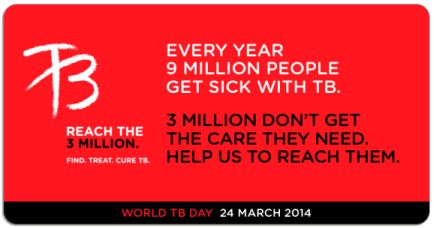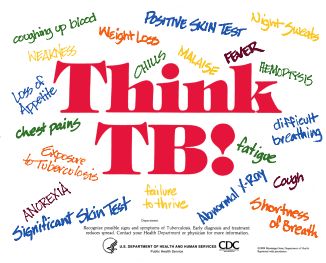World TB Day 2014

World TB Day, falling on March 24th each year aims to increase public awareness about tuberculosis (TB) and to support worldwide TB control efforts including efforts to eliminate the disease. It commemorates the day in 1882 when Dr Robert Koch announced that he had discovered the cause of tuberculosis, the TB bacillus. At the time of Koch's announcement in Berlin, TB was raging throughout Europe and the Americas, causing one out of every seven deaths. Koch's discovery opened the way towards diagnosing and curing TB.
While great strides have been made to control and cure TB, people still get sick and die from this disease. Much more needs to be done to eliminate this disease. TB remains an epidemic in much of the world, causing the deaths of nearly one-and-a-half million people each year, mostly in developing countries.
TB disease is preventable and treatable and one of the targets of “The Stop TB Partnership” hosted at the World Health Organization (WHO) is that the global incidence of TB disease will be less than 1 case per million population (elimination of TB as a global public health problem) by 2050. Progress towards global targets for reductions in TB cases and deaths in recent years has been impressive: TB mortality has fallen over 40% worldwide since 1990, and incidence is declining.(1) New TB tools such as rapid diagnostics are helping transform the response to the disease.
Theme for World TB Day 2014
The theme for World TB Day 2014 is “Reach the three million: A TB test, treatment and cure for all”. TB is curable, but current efforts to find, treat and cure everyone who gets ill with the disease are not sufficient. Globally, of the nine million people a year who get sick with TB, a third of them are "missed" by public health systems - The "missed" three million. Many of these three million people live in the world’s poorest, most vulnerable communities and include groups such as migrants, drug users and sex workers.
No one should be left behind in the fight against TB. This World TB Day, the call is for a global effort to find, treat and cure the three million and accelerate progress towards zero TB deaths, infections, suffering and stigma. Anyone can get TB, and current efforts to find and treat latent TB infection and TB disease are not sufficient. Misdiagnosis of TB still exists and health care professionals often do not "think TB."

WHO is advocating investment in basic research, and research and development for new tools - diagnostics, drugs and vaccines in order to reach people faster, treat them quicker and ultimately prevent them from becoming ill with TB. Achieving this, will help ensure realistic progress towards eliminating TB as a public health problem in the next two decades.
European Centre for Disease Prevention and Control
For 2014, the European Centre for Disease Prevention and Control (ECDC) has chosen multidrug resistance tuberculosis (MDR-TB) as the theme, particularly MDR-TB treatment and treatment outcomes. As part of the “Progress towards TB elimination in the EU”, a follow-up to the “Framework Action Plan to Fight TB in the EU”, ECDC has been monitoring the trend in new MDR-TB cases and treatment success. In the EU/EEA, the treatment success rates of MDR-TB patients have remained stable but at a very low level: only one in every three (34%) patients in the reporting EU/EEA countries finishes MDR-TB treatment successfully. The low treatment success rate in EU/EEA countries is considered a threat to patient survival and a risk for development of XDR-TB, which has even worse treatment outcomes.
MDR- and XDR-TB patients face much longer treatment, take more drugs, suffer from more side effects and treatment costs are five times higher compared to drug-susceptible TB. Only complete and successful tuberculosis treatment helps to prevent disease transmission. See also ECDC World TB Day 2014, Tuberculosis on the ECDC website.
Epidemiology of TB – Ireland
In 2013(i), there were 384 cases of TB reported in Ireland, a notification rate of 8.4 per 100,000. This is one of the lowest notification rates recorded since TB surveillance began in 1998 and remains stable compared to 2012(ii) when 364 cases (rate: 7.9/100,000) were notified.
In 2013, the notification rate for TB in the indigenous population was 5.5 per 100,000 while the rate in foreign-born persons was 22.2 per 100,000. The number of TB cases reported in Ireland has declined since the 1990s with 604 cases reported in 1992, a rate of 17.1 per 100,000. The decline has been even more considerable since the early 1950s when 7,000 cases of TB were notified annually.
More information on Tuberculosis in Ireland is available here. See also TB reports for Ireland.
References
1. World Health Organization. Global Tuberculosis Control 2012. WHO, Geneva, Switzerland. 2012. Available at: http://www.who.int/tb/publications/global_report/en/
More information on World TB Day 2014 is available at:
Stop TB Partnership
Stop TB Partnership “3 Million Brochure”
Stop TB Partnership Twitter
WHO Europe
European Centre for Disease Prevention and Control
Eurosurveillance, Volume 19, Issue 11, 20 March 2014-Special issue on TB
ECDC Twitter
World TB Day 2014 Facebook
Centers for Disease Prevention and Control USA
Australian TB Forum
(i) Data for 2013 are provisional
(ii) Data for 2012 are provisional


